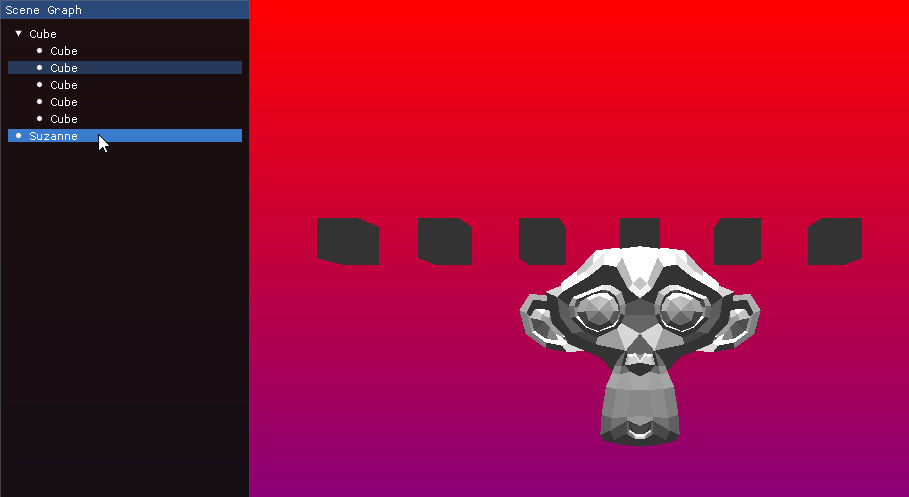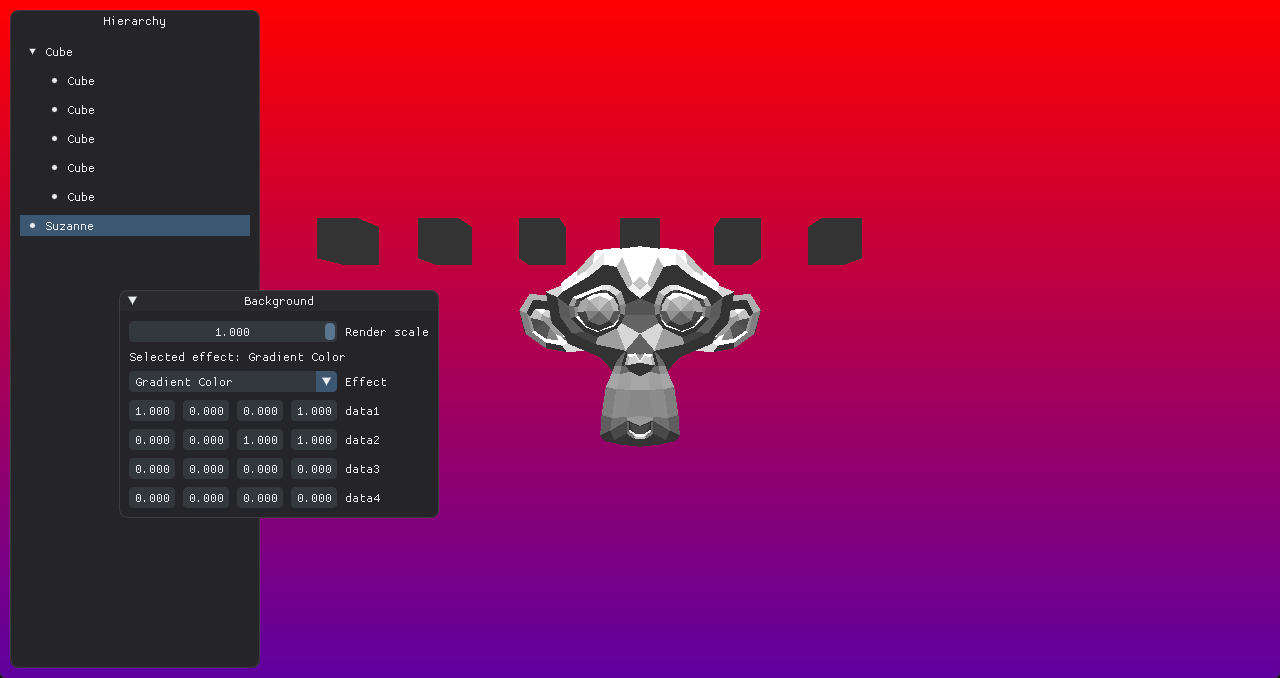Render Scene Tree UI
This tutorial will guide you through creating a scene tree viewer using ImGui. We'll build a simple tree view for our scene graph that displays nodes, supports selection, and handles parent-child relationships.
Main Window Setup
The engine_ui_definition procedure from drawing.odin is where we set up the ImGui window
that will house our scene tree.
engine_ui_definition :: proc(self: ^Engine) {
// imgui new frame
im_glfw.new_frame()
im_vk.new_frame()
im.new_frame()
v := im.get_main_viewport()
im.set_next_window_pos({10, 10})
im.set_next_window_size({250, v.work_size.y - 20})
im.begin("Hierarchy", nil, {.No_Focus_On_Appearing, .No_Collapse, .No_Resize})
@(static) selected_node: i32 = -1
for &hierarchy, i in self.scene.hierarchy {
if hierarchy.parent == -1 {
render_scene_tree_ui(&self.scene, i, &selected_node)
}
}
im.end()
//make imgui calculate internal draw structures
im.render()
}
-
We begin by configuring the window's position and size relative to the main viewport, placing it at top-left corner with a small offset (
10,10) for padding. It has a fixed width of250pixels and a height that dynamically spans the viewport’s working area, leaving a 20-pixel margin at the bottom to avoid overlapping other UI elements or the screen edge.v := im.get_main_viewport()
im.set_next_window_pos({10, 10})
im.set_next_window_size({250, v.work_size.y - 20}) -
The window, titled "Hierarchy," is created with flags that prevent it from being resized, collapsed, or focused on appearance, giving it a stable, docked appearance.
im.begin("Hierarchy", nil, {.No_Focus_On_Appearing, .No_Collapse, .No_Resize}) -
Inside this window, we define a static variable
selected_nodeto track the currently selected node across frames, then iterate through the scene's hierarchy to find and render root nodes.@(static) selected_node: i32 = -1
for &hierarchy, i in self.scene.hierarchy {
if hierarchy.parent == -1 {
render_scene_tree_ui(&self.scene, i, &selected_node)
}
}
Scene Tree Rendering
The render_scene_tree_ui procedure is responsible for rendering the scene tree with ImGui. It
handles displaying individual nodes, managing their appearance, detecting user interactions,
and traversing the hierarchy.
render_scene_tree_ui :: proc(scene: ^Scene, #any_int node: i32, selected_node: ^i32) -> i32 {
name := scene_get_node_name(scene, node)
label := len(name) == 0 ? "NO NODE" : name
is_leaf := scene.hierarchy[node].first_child < 0
flags: im.Tree_Node_Flags = is_leaf ? {.Leaf, .Bullet} : {}
if node == selected_node^ {
flags += {.Selected}
}
// Make the node span the entire width
flags += {.Span_Full_Width, .Frame_Padding}
is_opened := im.tree_node_ex_ptr(&scene.hierarchy[node], flags, "%s", cstring(raw_data(label)))
// Check for clicks in the entire row area
was_clicked := im.is_item_clicked()
im.push_id_int(node)
{
if was_clicked {
log.debugf("Selected node: %d (%s)", node, label)
selected_node^ = node
}
if is_opened {
for ch := scene.hierarchy[node].first_child;
ch != -1;
ch = scene.hierarchy[ch].next_sibling {
if sub_node := render_scene_tree_ui(scene, ch, selected_node); sub_node > -1 {
selected_node^ = sub_node
}
}
im.tree_pop()
}
}
im.pop_id()
return selected_node^
}
Here's how it works, broken down into clear steps:
-
We start by retrieving the node's name and determining whether it's a leaf node. The name is fetched using a helper procedure
scene_get_node_name, and if it's empty, we default to "NO NODE". We then check if the node is a leaf by examining itsfirst_childfield— if it's less than0, there are no children, marking it as a leaf.name := scene_get_node_name(scene, node)
label := len(name) == 0 ? "NO NODE" : name
is_leaf := scene.hierarchy[node].first_child < 0This is the code for
scene_get_node_name, place intoscene.odin:scene_get_node_name :: proc(self: ^Scene, #any_int node: i32) -> string {
name_idx := self.name_for_node[u32(node)]
if name_idx == NO_NAME {
return ""
}
return self.node_names[name_idx]
} -
Next, we configure the ImGui tree node flags to control its behavior and appearance. For leaf nodes, we set the
.Leafflag to remove the expand arrow and add.Bulletfor a small visual marker. If the current node matches the selected node, we include the.Selectedflag to highlight it. Finally, we add.Span_Full_Widthto make the node stretch across the window, ensuring the entire row is clickable, andFrame_Paddingto use the current frame padding settings, increasing the size of the tree node for better visibility and interaction.flags: im.Tree_Node_Flags = is_leaf ? {.Leaf, .Bullet} : {}
if node == selected_node^ {
flags += {.Selected}
}
flags += {.Span_Full_Width, .Frame_Padding} -
We them create the node using
im.tree_node_ex_ptr, passing the node pointer, flags, and the label as a formatted string.is_opened := im.tree_node_ex_ptr(
&scene.hierarchy[node],
flags,
"%s",
cstring(raw_data(label)),
) -
After rendering, we check for user interaction and handle node selection. We use
im.is_item_clicked()to detect if the node was clicked. To ensure ImGui widgets have unique IDs, we push the node's index onto the ID stack. If a click is detected, we log the selection and update theselected_nodepointer with the current node's index.// Check for clicks in the entire row area
was_clicked := im.is_item_clicked()
im.push_id_int(node)
{
if was_clicked {
log.debugf("Selected node: %d (%s)", node, label)
selected_node^ = node
} -
If the node is expanded (i.e.,
is_openedistrue), we recursively render its children. We start with thefirst_childof the current node and iterate through all siblings using thenext_siblingfield. For each child, we callrender_scene_tree_uirecursively, passing the same scene and selected node pointer. If a child returns a selected node index greater than-1, we updateselected_nodewith that value. After rendering all children, we callim.tree_pop()to close the tree node.if is_opened {
for ch := scene.hierarchy[node].first_child;
ch != -1;
ch = scene.hierarchy[ch].next_sibling {
if sub_node := render_scene_tree_ui(scene, ch, selected_node); sub_node > -1 {
selected_node^ = sub_node
}
}
im.tree_pop()
} -
Finally, we pop the ID stack to avoid conflicts with other nodes, ensuring ImGui's internal state remains consistent. The procedure returns the current value of
selected_node, which could have been updated either by clicking the current node or by a selection in one of its children.im.pop_id()
return selected_node^
This is the end result for this section:

Bonus: Update ImGui style
Maybe you are tired to see the default ImGui style, so lets change the base colors for a pleasant and modern dark theme with dark accents.
Add this to init.odin, just above engine_init_imgui procedure:
// odinfmt: disable
setup_imgui_style :: proc() {
style := im.get_style()
colors := &style.colors
// Base colors for a pleasant and modern dark theme with dark accents
colors[im.Col.Text] = {0.92, 0.93, 0.94, 1.00} // Light grey text for readability
colors[im.Col.Text_Disabled] = {0.50, 0.52, 0.54, 1.00} // Subtle grey for disabled text
colors[im.Col.Window_Bg] = {0.14, 0.14, 0.16, 1.00} // Dark background with a hint of blue
colors[im.Col.Child_Bg] = {0.16, 0.16, 0.18, 1.00} // Slightly lighter for child elements
colors[im.Col.Popup_Bg] = {0.18, 0.18, 0.20, 1.00} // Popup background
colors[im.Col.Border] = {0.28, 0.29, 0.30, 0.60} // Soft border color
colors[im.Col.Border_Shadow] = {0.00, 0.00, 0.00, 0.00} // No border shadow
colors[im.Col.Frame_Bg] = {0.20, 0.22, 0.24, 1.00} // Frame background
colors[im.Col.Frame_Bg_Hovered] = {0.22, 0.24, 0.26, 1.00} // Frame hover effect
colors[im.Col.Frame_Bg_Active] = {0.24, 0.26, 0.28, 1.00} // Active frame background
colors[im.Col.Title_Bg] = {0.14, 0.14, 0.16, 1.00} // Title background
colors[im.Col.Title_Bg_Active] = {0.16, 0.16, 0.18, 1.00} // Active title background
colors[im.Col.Title_Bg_Collapsed] = {0.14, 0.14, 0.16, 1.00} // Collapsed title background
colors[im.Col.Menu_Bar_Bg] = {0.20, 0.20, 0.22, 1.00} // Menu bar background
colors[im.Col.Scrollbar_Bg] = {0.16, 0.16, 0.18, 1.00} // Scrollbar background
colors[im.Col.Scrollbar_Grab] = {0.24, 0.26, 0.28, 1.00} // Dark accent for scrollbar grab
colors[im.Col.Scrollbar_Grab_Hovered]= {0.28, 0.30, 0.32, 1.00} // Scrollbar grab hover
colors[im.Col.Scrollbar_Grab_Active] = {0.32, 0.34, 0.36, 1.00} // Scrollbar grab active
colors[im.Col.Check_Mark] = {0.46, 0.56, 0.66, 1.00} // Dark blue checkmark
colors[im.Col.Slider_Grab] = {0.36, 0.46, 0.56, 1.00} // Dark blue slider grab
colors[im.Col.Slider_Grab_Active] = {0.40, 0.50, 0.60, 1.00} // Active slider grab
colors[im.Col.Button] = {0.24, 0.34, 0.44, 1.00} // Dark blue button
colors[im.Col.Button_Hovered] = {0.28, 0.38, 0.48, 1.00} // Button hover effect
colors[im.Col.Button_Active] = {0.32, 0.42, 0.52, 1.00} // Active button
colors[im.Col.Header] = {0.24, 0.34, 0.44, 1.00} // Header color similar to button
colors[im.Col.Header_Hovered] = {0.28, 0.38, 0.48, 1.00} // Header hover effect
colors[im.Col.Header_Active] = {0.32, 0.42, 0.52, 1.00} // Active header
colors[im.Col.Separator] = {0.28, 0.29, 0.30, 1.00} // Separator color
colors[im.Col.Separator_Hovered] = {0.46, 0.56, 0.66, 1.00} // Hover effect for separator
colors[im.Col.Separator_Active] = {0.46, 0.56, 0.66, 1.00} // Active separator
colors[im.Col.Resize_Grip] = {0.36, 0.46, 0.56, 1.00} // Resize grip
colors[im.Col.Resize_Grip_Hovered] = {0.40, 0.50, 0.60, 1.00} // Hover effect for resize grip
colors[im.Col.Resize_Grip_Active] = {0.44, 0.54, 0.64, 1.00} // Active resize grip
colors[im.Col.Tab] = {0.20, 0.22, 0.24, 1.00} // Inactive tab
colors[im.Col.Tab_Hovered] = {0.28, 0.38, 0.48, 1.00} // Hover effect for tab
colors[im.Col.Tab_Selected] = {0.24, 0.34, 0.44, 1.00} // Active tab color (TabActive)
colors[im.Col.Tab_Dimmed] = {0.20, 0.22, 0.24, 1.00} // Unfocused tab (TabUnfocused)
colors[im.Col.Tab_Dimmed_Selected] = {0.24, 0.34, 0.44, 1.00} // Active but unfocused tab (TabUnfocusedActive)
colors[im.Col.Docking_Preview] = {0.24, 0.34, 0.44, 0.70} // Docking preview
colors[im.Col.Docking_Empty_Bg] = {0.14, 0.14, 0.16, 1.00} // Empty docking background
colors[im.Col.Plot_Lines] = {0.46, 0.56, 0.66, 1.00} // Plot lines
colors[im.Col.Plot_Lines_Hovered] = {0.46, 0.56, 0.66, 1.00} // Hover effect for plot lines
colors[im.Col.Plot_Histogram] = {0.36, 0.46, 0.56, 1.00} // Histogram color
colors[im.Col.Plot_Histogram_Hovered]= {0.40, 0.50, 0.60, 1.00} // Hover effect for histogram
colors[im.Col.Table_Header_Bg] = {0.20, 0.22, 0.24, 1.00} // Table header background
colors[im.Col.Table_Border_Strong] = {0.28, 0.29, 0.30, 1.00} // Strong border for tables
colors[im.Col.Table_Border_Light] = {0.24, 0.25, 0.26, 1.00} // Light border for tables
colors[im.Col.Table_Row_Bg] = {0.20, 0.22, 0.24, 1.00} // Table row background
colors[im.Col.Table_Row_Bg_Alt] = {0.22, 0.24, 0.26, 1.00} // Alternate row background
colors[im.Col.Text_Selected_Bg] = {0.24, 0.34, 0.44, 0.35} // Selected text background
colors[im.Col.Drag_Drop_Target] = {0.46, 0.56, 0.66, 0.90} // Drag and drop target
colors[im.Col.Nav_Cursor] = {0.46, 0.56, 0.66, 1.00} // Navigation highlight (NavHighlight)
colors[im.Col.Nav_Windowing_Highlight]= {1.00, 1.00, 1.00, 0.70} // Windowing highlight
colors[im.Col.Nav_Windowing_Dim_Bg] = {0.80, 0.80, 0.80, 0.20} // Dim background for windowing
colors[im.Col.Modal_Window_Dim_Bg] = {0.80, 0.80, 0.80, 0.35} // Dim background for modal windows
// Style adjustments
style.window_rounding = 8.0 // Softer rounded corners for windows
style.frame_rounding = 4.0 // Rounded corners for frames
style.scrollbar_rounding = 6.0 // Rounded corners for scrollbars
style.grab_rounding = 4.0 // Rounded corners for grab elements
style.child_rounding = 4.0 // Rounded corners for child windows
style.window_title_align = {0.50, 0.50} // Centered window title
style.window_padding = {10.0, 10.0} // Comfortable padding
style.frame_padding = {6.0, 4.0} // Frame padding
style.item_spacing = {8.0, 8.0} // Item spacing
style.item_inner_spacing = {8.0, 6.0} // Inner item spacing
style.indent_spacing = 22.0 // Indentation spacing
style.scrollbar_size = 16.0 // Scrollbar size
style.grab_min_size = 10.0 // Minimum grab size
style.anti_aliased_lines = true // Enable anti-aliased lines
style.anti_aliased_fill = true // Enable anti-aliased fill
}
// odinfmt: enable
Style attributions go to shivang51 from the bess repository.
Next, call setup_imgui_style() at the end of the engine_init_imgui procedure to
apply the custom style.
This is the end result with the new style:

Conclusion
Our tree view might not have editing options yet, but it’s a great starting point for integrating scene graphs into the engine, setting the framework for more advanced functionality in upcoming chapters.